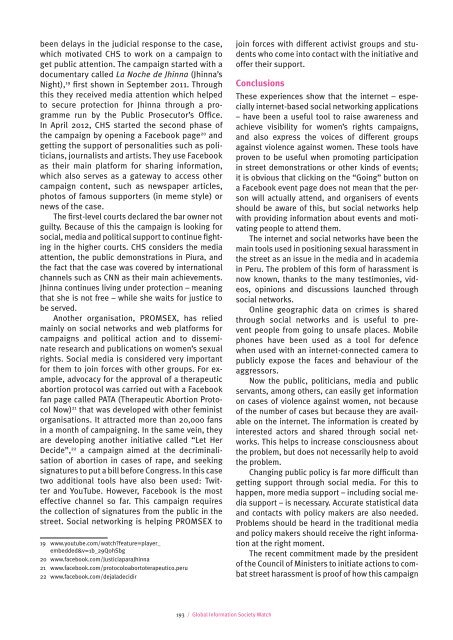gisw13_chapters
gisw13_chapters
gisw13_chapters
Create successful ePaper yourself
Turn your PDF publications into a flip-book with our unique Google optimized e-Paper software.
een delays in the judicial response to the case,which motivated CHS to work on a campaign toget public attention. The campaign started with adocumentary called La Noche de Jhinna (Jhinna’sNight), 19 first shown in September 2011. Throughthis they received media attention which helpedto secure protection for Jhinna through a programmerun by the Public Prosecutor’s Office.In April 2012, CHS started the second phase ofthe campaign by opening a Facebook page 20 andgetting the support of personalities such as politicians,journalists and artists. They use Facebookas their main platform for sharing information,which also serves as a gateway to access othercampaign content, such as newspaper articles,photos of famous supporters (in meme style) ornews of the case.The first-level courts declared the bar owner notguilty. Because of this the campaign is looking forsocial, media and political support to continue fightingin the higher courts. CHS considers the mediaattention, the public demonstrations in Piura, andthe fact that the case was covered by internationalchannels such as CNN as their main achievements.Jhinna continues living under protection – meaningthat she is not free – while she waits for justice tobe served.Another organisation, PROMSEX, has reliedmainly on social networks and web platforms forcampaigns and political action and to disseminateresearch and publications on women’s sexualrights. Social media is considered very importantfor them to join forces with other groups. For example,advocacy for the approval of a therapeuticabortion protocol was carried out with a Facebookfan page called PATA (Therapeutic Abortion ProtocolNow) 21 that was developed with other feministorganisations. It attracted more than 20,000 fansin a month of campaigning. In the same vein, theyare developing another initiative called “Let HerDecide”, 22 a campaign aimed at the decriminalisationof abortion in cases of rape, and seekingsignatures to put a bill before Congress. In this casetwo additional tools have also been used: Twitterand YouTube. However, Facebook is the mosteffective channel so far. This campaign requiresthe collection of signatures from the public in thestreet. Social networking is helping PROMSEX to19 www.youtube.com/watch?feature=player_embedded&v=1b_29Q0hSbg20 www.facebook.com/JusticiaparaJhinna21 www.facebook.com/protocoloabortoterapeutico.peru22 www.facebook.com/dejaladecidirjoin forces with different activist groups and studentswho come into contact with the initiative andoffer their support.ConclusionsThese experiences show that the internet – especiallyinternet-based social networking applications– have been a useful tool to raise awareness andachieve visibility for women’s rights campaigns,and also express the voices of different groupsagainst violence against women. These tools haveproven to be useful when promoting participationin street demonstrations or other kinds of events;it is obvious that clicking on the “Going” button ona Facebook event page does not mean that the personwill actually attend, and organisers of eventsshould be aware of this, but social networks helpwith providing information about events and motivatingpeople to attend them.The internet and social networks have been themain tools used in positioning sexual harassment inthe street as an issue in the media and in academiain Peru. The problem of this form of harassment isnow known, thanks to the many testimonies, videos,opinions and discussions launched throughsocial networks.Online geographic data on crimes is sharedthrough social networks and is useful to preventpeople from going to unsafe places. Mobilephones have been used as a tool for defencewhen used with an internet-connected camera topublicly expose the faces and behaviour of theaggressors.Now the public, politicians, media and publicservants, among others, can easily get informationon cases of violence against women, not becauseof the number of cases but because they are availableon the internet. The information is created byinterested actors and shared through social networks.This helps to increase consciousness aboutthe problem, but does not necessarily help to avoidthe problem.Changing public policy is far more difficult thangetting support through social media. For this tohappen, more media support – including social mediasupport – is necessary. Accurate statistical dataand contacts with policy makers are also needed.Problems should be heard in the traditional mediaand policy makers should receive the right informationat the right moment.The recent commitment made by the presidentof the Council of Ministers to initiate actions to combatstreet harassment is proof of how this campaign193 / Global Information Society Watch


